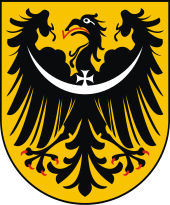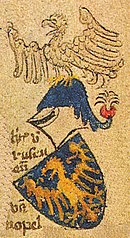Piast dynasty
![]()
This article describes the Piast dynasty. For the company see Piast (company).
The Piast were the high medieval ruling dynasty in Poland including (temporary) split-offs in Mazovia and Silesia, which provided numerous kings and dukes between the 10th and 17th centuries. They are said to be descended from the tribe of the Polans, which was first mentioned in the year 1000. Legendary progenitor is said to have been the Polan prince Piast († around 870). The first duke to rise to king in 1025 was Bolesław I the Brave (Bolesław Chrobry), who fought alongside the Roman-German Emperor Otto III against the pagan Lutizes.
The Polish ruling dynasty of the Piasts split into five lines in the 12th and 13th centuries, forming the Union of Polish Duchies, headed by an elected senior duke. However, the lineages also warred with each other at times. One of these was the Silesian Piasts, who ruled the Duchy of Silesia from 1138 and split into various branches from 1249, which subsequently ruled most of the numerous duchies in Silesia. Five Silesian piastes became senior Polish dukes. Through marriage to German princesses and the German eastern colonization movement, the Silesian Piasts gradually became a German noble family. Between 1289 and 1342, the Silesian Piasts gradually broke away from the union of the Polish duchies and subordinated themselves to the Bohemian Crown.
In 1370 the Polish Piasts died out with King Casimir III, who was succeeded after a transitional period by the Jagiellonian dynasty. Casimir had renounced the feudal sovereignty over the Silesian duchies in 1335. The last branch of the Silesian Piasts became extinct in 1675 with Duke George William of Liegnitz-Brieg-Wohlau in Upper Silesia.

Polish eagle, coat of arms of the Piast kings
History
→ Main article: History of Poland
The first ruling centre of the Piast dynasty was a fortification in Giecz in 940. Shortly afterwards, nearby Gniezno took over this function. The written history of Poland began with Duke Misaca, later called Mieszko I, his baptism in 966 and the development of the first state entity on the territory of the Polish landscape part of Greater Poland (Poznan-Gnesen-Calian) under the Piast dynasty. The name "Polani" is documented only from 1015.
The temporarily independent Mazovian Piasts died out in 1526 and Mazovia was reunited with Poland. The Silesian Piasts, subject to the Bohemian Crown since the 14th century and at the same time to the Roman-German Empire, died out in the male line in 1675.
Through conquests, Pomerania, Bohemia and both Lusatia were temporarily part of the Piasts' territory, later Ruthenia, as well as the Spis in Upper Hungary, today's Slovakia, through seizure.
The neighbourhood of this Poland to the Holy RomanEmpire caused a partly tense coexistence, in which isolated Piast (for example Mieszko I. , Casimir I the Renewer, Władysław I (Herman)) sought to protect their state from external interference through oaths of allegiance or tribute to the Roman-German emperors, marriages with representatives of the German high nobility (Salians, Ottonians) and other treaties. In a papal excerpt mentioned about 1080, a Dagome Iudex of the year 991/2 is mentioned, where, as it is assumed, Mieszko I handed over the realm of the Poles into papal custody (St. Peter's pence). The titles of the later so-called Piast varied, depending on their position of power, between duke and king. Other influential neighbours of Piast Poland at that time were the Kingdom of Bohemia under the Přemyslids, the Kingdom of Hungary under the Árpáds and the Angevins, the Empire of Kievan Rus, and from the late 13th century the Teutonic Order and the Grand Duchy of Lithuania.
With the death of Bolesław III Schiefmund in 1138, the particularism that was to determine Poland's destiny for almost 150 years broke out in Poland. Poland broke into a multitude of intermittently warring piastic duchies, greatly weakening Poland's political position and authority in 13th-century Europe. With Bolesław's death, the seniority principle became legally effective, but did not prevent numerous warlike conflicts between the Piast rulers of the Polish constituent duchies. The respective rulers of Kraków, the capital of the seniorate province of Lesser Poland, were "senior dukes", while the family members subordinate to them were "junior dukes". Some of these territorial princes - especially Mieszko III, Władysław III Dunbein, Leszek I the White and the Silesian scions of the dynasty (see: Silesian Piasts) - ascended the Kraków throne several times and were also deposed several times.
The "Golden Age of the Piasts" ended when the royal and at the same time youngest line of the Piasts, descended from the youngest son of Bolesław III, became extinct with King Casimir III the Great in 1370. The Mazovian line became extinct in 1526, but the Silesian and at the same time oldest line continued to flourish and rule, albeit outside Poland from 1348. Of these, the Teschen branch died out in 1625. The last legitimate male descendant of the dynasty, August Baron of Liegnitz, died in 1679. He was the offspring of an improper marriage, which is why he was not allowed to use the title of duke and was not entitled to inherit. The last reigning duke of Liegnitz, Brieg and Wohlau and at the same time the last Silesian Piast was Duke Georg Wilhelm. His sister Charlotte died in 1707 and is buried in the monastery church in Trebnitz next to the sarcophagus of her ancestor, St Hedwig of Silesia.
If one counts the line of the Barons of Hohenstein represented in Upper Silesia among the Piast, which however arose from an illegitimate union, then the great-grandson of the Teschen Prince Adam Wenzel († 1617), Ferdinand II. Freiherr von und zu Hohenstein († 3 April 1706), was also a male Piast. However, this is disputed, as he is not considered a legitimate scion of the Piast dynasty. George-Wilhelm I (Liegnitz-Brieg-Wohlau) had an illegitimate child Martin with Dorthea Thugendreich von Streit im Feld. Martin von Streit im Feld or Streitenfeld, born 21 January 1676, continued the oldest line with his descendants, the Counts and Barons von Streit and still exists as a line.
From 1370, after the death of Casimir the Great, the last king of the Piast dynasty, Poland was ruled in personal union by his nephew, the Hungarian King Louis I of Anjou (collateral line of the Capetians). The ruler was to be inherited by his daughters after his death (1382). The Polish throne went to the younger Hedwig. Because of the common threat from the Order, Poland allied itself with Lithuania, and the queen married the Lithuanian Grand Duke Jogaila. The marriage was childless, and after Hedwig's death Jogaila remained on the Polish throne as sole ruler and became progenitor of all subsequent Jagiellonian kings. He was followed by his sons from a later marriage.

The black ducal eagle of Sagan, Lower Silesia
Ruler from the House of the Piast
Legendary princes
- Piast († c. 870), prince of the Polans
- Ziemowit
- Leszek († around 930)
- Ziemomysł
List of piastic rulers of Poland
See also: List of Polish rulers
- Mieszko I. , Duke 960-992
- Bolesław I the Brave, Duke 992-1025, King 1025
- Mieszko II Lambert, king 1025-1031, duke 1032-1034
- Casimir I the Renewer, Duke 1034-1058
- Bolesław II the Bold, duke 1058-1079, king 1076-1079
- Władysław I Herman, Senior of Poland, Duke of Mazovia 1079-1102
- Zbigniew, Duke 1102-1107
- Bolesław III Schiefmund, 1102-1138
- Władysław II the Expelled, Duke 1138-1146 SL
- Bolesław IV the Curmudgeon, Duke 1146-1173
- Mieszko III the Old, Duke 1173-1177, 1198-1202 GL
- Casimir II the Just, Duke 1177-1194 JL
- Leszek I the White, Duke 1194-1198, 1206-1210, 1211-1227 JL
- Władysław III Dunbein, duke 1202-1206, 1228-1229 GL
- Mieszko I Crossbone, Duke 1210-1211 SL
- Conrad I of Mazovia, Duke 1229-1232, 1241-1243 JL
- Henry I the Bearded, Duke 1232-1238 SL
- Henry II the Pious, Duke 1238-1241 SL
- Bolesław V the Shameful, Duke 1243-1279 JL
- Leszek II the Black, Duke 1279-1288 JL
- Henry IV Probus, Duke 1288-1290 SL
- Przemysł II. (I.), Duke 1290-1295, King 1295-1296 GL
- Wenceslas II, 1300-1305 King of Bohemia and Poland (GL)*.
- Wenceslas III, 1305-1306 King of Bohemia and Poland (GL)*.
- Władysław IV. (I.) Ellenlang, duke 1306-1320, king 1320-1333 JL
- Casimir III. (I.) the Great, King 1333-1370 JL
* From the Bohemian dynasty of the Přemyslids, related to the Piasts on the spindle side. Wenceslas II married a daughter of King Przemysł II.
GL - Great Polish line (Great Poland in Poznan, Kalisz and Gniezno), descendants of Mieszko III the Old.
JL - youngest line (Mazovia, Kujawy, Lesser Poland, Sieradz and Łęczyca), descendants of Casimir II the Just.
SL - oldest line (Silesia), descendants of Władysław II the Expelled.
List of important Kujawsko-Mazovian dukes from the house of the Piast dynasty
- Władysław I Herman, Senior of Poland, Duke of Mazovia 1079-1102
- Casimir II the Just, from 1173 Duke of Lesser Poland in Sandomir, 1177-1194 Senior Duke of Poland, from 1186 also Duke of Mazovia-Kujavia
- Leszek I the White, from 1194 Duke of Lesser Poland in Sandomir and of Mazovia, since 1199 respectively 1206 Senior Duke of Poland, 1199-1200 Duke of Kujawy
- Konrad I of Mazovia, from 1199 Duke in Mazovia, from 1202 Duke in Kujawy, Sieradz and Łęczyca, and 1229-1232 and 1241-1243 Senior Duke of Poland.
- Casimir I, Duke of Kujawy 1233-1267
- Siemomysław, Duke of Kujawy 1267-1287
- Leszek II the Black, from 1261 Duke of Sieradz, from 1267 of Łęczyca, from 1273 of Kujawy, 1279-1288 Senior Duke of Poland.
- Casimir III, Duke of Kujawy 1314-1347
- Wladyslaw, Duke of Kujawy 1347-1364
- Janusz III, Duke of Mazovia 1503-1526
List of important Silesian dukes from the house of the Piast dynasty
→ Main article: List of the Dukes of Silesia
→ Main article: Silesian Piast
→ Main article: History of Silesia

The coat of arms of Wladislaus II (Oppeln) from Armorial Gelre, Upper Silesia
Search within the encyclopedia